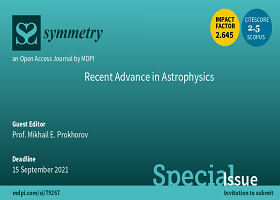Recent Advance in Astrophysics
A special issue of Symmetry (ISSN 2073-8994). This special issue belongs to the section "Physics".
Deadline for manuscript submissions: closed (30 April 2022) | Viewed by 6957

Special Issue Editors
Interests: binary stars; neutron stars; black holes; accretion; stellar photometry; orientation in space
Interests: quantum information; visualization; turbulence; signal processing; computer simulation; interstellar medium; gas dynamics; galaxy dynamics; hydrodynamical instabilities; accretion processes; radar astronomy; fractal calculus
Special Issue Information
Dear Colleagues,
Symmetry and its violation are not the most common features of astrophysical processes, but these phenomena are found in all areas of astrophysical research. These manifestations include axisymmetric accretion disks and their disturbance by tidal forces, the emergence and maintenance of spiral arms in galaxies, symmetry breaking during phase transitions in the early universe and during baryosynthesis, asymmetry during supernova explosions, single and double jets in quasars and gamma-ray bursts, gravitational lensing and resonance phenomena in celestial mechanics, etc.
This Special Issue of the interdisciplinary journal Symmetry will collect observational and theoretical contributions related to symmetry or its violation from various fields of astrophysics, astronomy, and unrelated disciplines.
Prof. Mikhail E. Prokhorov
Guest Editor
Prof. Dr. Ilya Kovalenko
Co-Guest Editor
Manuscript Submission Information
Manuscripts should be submitted online at www.mdpi.com by registering and logging in to this website. Once you are registered, click here to go to the submission form. Manuscripts can be submitted until the deadline. All submissions that pass pre-check are peer-reviewed. Accepted papers will be published continuously in the journal (as soon as accepted) and will be listed together on the special issue website. Research articles, review articles as well as short communications are invited. For planned papers, a title and short abstract (about 250 words) can be sent to the Editorial Office for assessment.
Submitted manuscripts should not have been published previously, nor be under consideration for publication elsewhere (except conference proceedings papers). All manuscripts are thoroughly refereed through a single-blind peer-review process. A guide for authors and other relevant information for submission of manuscripts is available on the Instructions for Authors page. Symmetry is an international peer-reviewed open access monthly journal published by MDPI.
Please visit the Instructions for Authors page before submitting a manuscript. The Article Processing Charge (APC) for publication in this open access journal is 2400 CHF (Swiss Francs). Submitted papers should be well formatted and use good English. Authors may use MDPI's English editing service prior to publication or during author revisions.
Keywords
- accretion discs
- binary stars
- variable stars
- early universe
- jets
- supernova
- gamma-ray bursts
- celestial mechanics
- tides
- gravitational lensing
- spiral arms in galaxies
Benefits of Publishing in a Special Issue
- Ease of navigation: Grouping papers by topic helps scholars navigate broad scope journals more efficiently.
- Greater discoverability: Special Issues support the reach and impact of scientific research. Articles in Special Issues are more discoverable and cited more frequently.
- Expansion of research network: Special Issues facilitate connections among authors, fostering scientific collaborations.
- External promotion: Articles in Special Issues are often promoted through the journal's social media, increasing their visibility.
- Reprint: MDPI Books provides the opportunity to republish successful Special Issues in book format, both online and in print.
Further information on MDPI's Special Issue policies can be found here.






